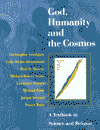The Role of Model and MetaphorOne of <!g>Ian Barbour’s great contributions to
the science-and-religion debate was to indicate as long ago as 1974 in Myths, Models and Paradigms how central
to both scientific and religious frameworks is the role of models. Models in scienceA model in science can be thought of as a means whereby the human imagination can engage with and depict the aspect of nature under investigation. A good example is the one Barbour himself
uses Models in theologyIf we now consider as an example of a model in Christian theology one of <!g>Augustine’s ‘psychological’ models of the Trinity - the relationship between Father, Son and Spirit being seen as like - but yet not like - the relation between memory, understanding and will in the human mind - we can see all sorts of similarities with the part models play in science. The model emerged in a situation of difficulty and controversy - this time over how to imagine God. Augustine’s was one of a number of attempts to picture how God might be like - but yet not like - three co-equal entities in relationship. Again, it was a model which greatly stimulated theological debate and led ultimately to a new conceptual framework. But these similarities between the use of models in science and in theology should not be allowed to disguise differences. Augustine’s model remains just one of a range of ways of stretching the imagination towards the mystery of the Trinity. No great advance has superseded it, yet it does not hold sway. More importantly, a whole range of earlier understandings of the relationship between Father, Son and Spirit remains alive for the Christian community in the Scriptures. The whole spectrum of titles for Jesus remains just as important as it was before the work of the Fathers of the 4th and 5th Centuries. One of T.S.<!g>Kuhn’s points is particularly
relevant here - he notes that a science does not teach its students, to any
great extent, the classic texts of the past, however seminal they might have
been. Both in science and religion human exploration requires both the imaginative and metaphorical on the one hand and the conceptual and systematic on the other. Models are what connects them. They are necessarily provisional and heuristic in character.
Email
link | Feedback | Contributed by: <!g>Dr. Christopher Southgate
|






